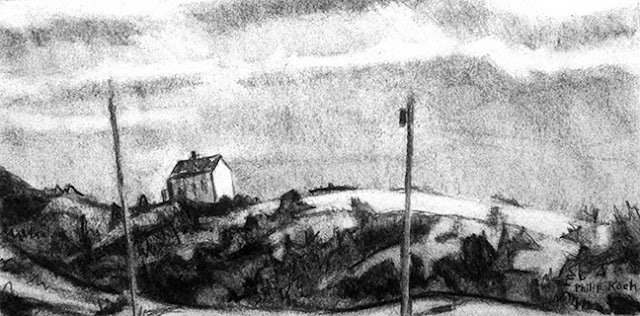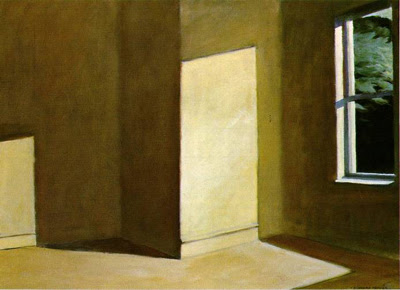Charles Burchfield and Me (Part II)
This is Part II of the short essay I wrote inspired by my visit to the Burchfield Penney Art Center in Buffalo, NY last Friday...
Burchfield came of age as a painter in a time when artists had the winds of modernism at their backs. They delighted in re-emphasizing the beauty of mark making on the surface of the canvas in elegant patterns. Burchfield to me took the best from the modernist toolbag and reinterpreted the tradition of American nature painting through 20th century eyes. And he was frighteningly good at it.

Charles Burchfield, Early Spring, watercolor, 37 1/8 x 42 1/4"
1966-67
His Early Spring strikes me as both felicitous and at the same time a solemn reflection on the difficult passage from winter to spring. At first the golds in the fields and in the budding trees strike the viewer. But looking longer one sees all this warmth sits atop a deeper layer of silvery cold grays and blue blacks. I think the sharply pointed dark shape in the center of the stand of trees personifies winter and retains considerable force. Spring is coming, Burchfield's painting tells us, but winter isn't quite ready to leave the stage and can still pack a punch if it wishes.
Burchfield's paintings feel so familiar to me, probably because we shared similar experiences in nature growing up. Even as a child Burchfield was an amost fanatical amateur naturalist. For me, growing up on the deep forest of what was then a very rural Webster, NY, nature was one of the few playmates to be had. I spent a lot of my childhood playing by myself in the woods. A lot of what was influencing the young Burchfield echoed around me as well. It preconditioned me to feel at home in Burchfield's paintings.
Weather is a big deal in Western New York and Northeast Ohio, one of the snowiest regions of country. I lived for 18 years on the shore of Lake Ontario just east of Rochester and then spent four years just west of Cleveland in Oberlin, Ohio (the two blue dots below). Burchfield was born in Ashtabula, OH on Lake Erie and moved with his widowed mother to Salem a few miles to the south (the two red dots at the left). He later spent four years at the Cleveland School of Art (now Cleveland Institute of Art) where I studied drawing the figure in 1970). And in the second half of his life Burchfield worked in Buffalo and lived in a suburb sourtheast of the city.
In 1995 I had a solo exhibition in Burchfield's Ohio hometown at the Butler Institute of American Art's Salem Museum, a few blocks from Burchfield's simple home, now the Burchfield Homestead Museum. One can visit there as I did when I was in Salem and see where he made many of his early masterpieces.
I love Burchfield's paintings. Studying them over the last several decades has made me a far better artist myself. But I have no desire to imitate his style of painting in any direct way. His is too personal and too idiosyncratic a way of painting to provide a ready recipe. But I savor the energy and the familiar mysteries I find in his works.
And there is a final reason he is such a source for me. So much of the artworld in my lifetime has been centered around New York, Chicago, and Los Angeles. For an artist like me who spent his first 24 years living in Western New York, Ohio, and Indiana, one can have a nagging suspicion that those who say real artists "go to New York" might have a point. I lived in New York City and while I learned a lot ( I was studying at the Art Students League of New York), I never felt at home there. It was too noisy, and one never saw the stars. I missed those things. Over time I've found any art I make has to have something of my immediate surroundings in it for it to be any good. For a landscape painter like myself, so much more so.
By example Burchfield has been a powerful unapologetic reminder that an artist who is open to both his surroundings and to his inner life can do great things wherever they find themselves. The sun shines as brightly on the forests of Salem and near Buffalo as it does on the trees in Central Park in Manhattan. Burchfield was proud of his attachments and knew within them were the seeds of his greatness as a painter. For an artist like myself who seems destined to live most of his life outside one the the great metropolises, this is a crucial reassurance. Among Burchfield's gifts to me is an extra measure of confidence I can be "the real thing."
Returning to that beautiful Burchfield watercolor Early Spring that I began with, I wanted to share two of my favorites of my own paintings. Like Burchfield they show a real measure of expressionist exuberance and a love of patterned mark making. But their color and overall mood aren't likely to be mistaken for Burchfield.
Burchfield came of age as a painter in a time when artists had the winds of modernism at their backs. They delighted in re-emphasizing the beauty of mark making on the surface of the canvas in elegant patterns. Burchfield to me took the best from the modernist toolbag and reinterpreted the tradition of American nature painting through 20th century eyes. And he was frighteningly good at it.

Charles Burchfield, Early Spring, watercolor, 37 1/8 x 42 1/4"
1966-67
His Early Spring strikes me as both felicitous and at the same time a solemn reflection on the difficult passage from winter to spring. At first the golds in the fields and in the budding trees strike the viewer. But looking longer one sees all this warmth sits atop a deeper layer of silvery cold grays and blue blacks. I think the sharply pointed dark shape in the center of the stand of trees personifies winter and retains considerable force. Spring is coming, Burchfield's painting tells us, but winter isn't quite ready to leave the stage and can still pack a punch if it wishes.
Burchfield's paintings feel so familiar to me, probably because we shared similar experiences in nature growing up. Even as a child Burchfield was an amost fanatical amateur naturalist. For me, growing up on the deep forest of what was then a very rural Webster, NY, nature was one of the few playmates to be had. I spent a lot of my childhood playing by myself in the woods. A lot of what was influencing the young Burchfield echoed around me as well. It preconditioned me to feel at home in Burchfield's paintings.
Weather is a big deal in Western New York and Northeast Ohio, one of the snowiest regions of country. I lived for 18 years on the shore of Lake Ontario just east of Rochester and then spent four years just west of Cleveland in Oberlin, Ohio (the two blue dots below). Burchfield was born in Ashtabula, OH on Lake Erie and moved with his widowed mother to Salem a few miles to the south (the two red dots at the left). He later spent four years at the Cleveland School of Art (now Cleveland Institute of Art) where I studied drawing the figure in 1970). And in the second half of his life Burchfield worked in Buffalo and lived in a suburb sourtheast of the city.
In 1995 I had a solo exhibition in Burchfield's Ohio hometown at the Butler Institute of American Art's Salem Museum, a few blocks from Burchfield's simple home, now the Burchfield Homestead Museum. One can visit there as I did when I was in Salem and see where he made many of his early masterpieces.
I love Burchfield's paintings. Studying them over the last several decades has made me a far better artist myself. But I have no desire to imitate his style of painting in any direct way. His is too personal and too idiosyncratic a way of painting to provide a ready recipe. But I savor the energy and the familiar mysteries I find in his works.
And there is a final reason he is such a source for me. So much of the artworld in my lifetime has been centered around New York, Chicago, and Los Angeles. For an artist like me who spent his first 24 years living in Western New York, Ohio, and Indiana, one can have a nagging suspicion that those who say real artists "go to New York" might have a point. I lived in New York City and while I learned a lot ( I was studying at the Art Students League of New York), I never felt at home there. It was too noisy, and one never saw the stars. I missed those things. Over time I've found any art I make has to have something of my immediate surroundings in it for it to be any good. For a landscape painter like myself, so much more so.
By example Burchfield has been a powerful unapologetic reminder that an artist who is open to both his surroundings and to his inner life can do great things wherever they find themselves. The sun shines as brightly on the forests of Salem and near Buffalo as it does on the trees in Central Park in Manhattan. Burchfield was proud of his attachments and knew within them were the seeds of his greatness as a painter. For an artist like myself who seems destined to live most of his life outside one the the great metropolises, this is a crucial reassurance. Among Burchfield's gifts to me is an extra measure of confidence I can be "the real thing."
Returning to that beautiful Burchfield watercolor Early Spring that I began with, I wanted to share two of my favorites of my own paintings. Like Burchfield they show a real measure of expressionist exuberance and a love of patterned mark making. But their color and overall mood aren't likely to be mistaken for Burchfield.
Philip Koch, The Birches of Maine, oil on canvas
55 x 44", 2008, private collection Phladelphia
Philip Koch, The Red Whisper, oil on canvas, 30 x 40", 2006






